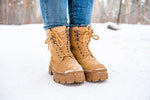
Should Winter Boots Be a Size Bigger?
, by Ed Stone, 5 min reading time

, by Ed Stone, 5 min reading time
As anyone who’s ever braved a blizzard knows, our toes tend to be the first extremities to feel the bitter cold weather. Fortunately for our feet, a high-quality pair of winter boots, like Lugz winter boots, Timberland boots for men and women, or Sketchers winter boots, provide warmth while battling against wear from salt and snow.
But figuring out the exact fit of those boots can be a little tricky—should winter boots be a size bigger than your usual loafers? How tight should they feel in the toes?
If you’re asking yourself these questions, we want to give you an expert opinion on how to choose your winter boots’ ideal sizing. Below, we’ll detail how your winter boots should fit, plus tips on how to get the coziest winter footwear experience possible.
When you first try on a pair of boots, they may feel so new that you may be immediately tempted to take them off (especially if they’re pinching or chafing the toes). And while that “breaking in” period may not be the most comfortable, you can make things easier on your feet by wearing thick socks until they start to feel a little cozier.
That said, the problem isn’t that your winter boots will take a few wears to break in—it’s that that slight discomfort may keep you from knowing whether you’ve got the right size to begin with.
A gauge for boot sizing is confirming that your winter boots fit snug around the arch and loose in the toe box. Making sure you’ve got a little wiggle room for your toes is key for two reasons:
Finding the balance between a roomy toe box and a boot that’s too loose can take a little trial and error. To help ease the process, make sure to try them on with thick socks. This will ensure your toes aren’t rubbing up against the outer contour of the shoe when trying on a fresh pair.
If you’re asking yourself, “Should I buy winter boots a size bigger?” the answer is, maybe—but there’s no one-size-fits-all answer here.
In the world of winter boots, there isn’t much sizing standardization across brands and styles. You may find a pair of nylon quilted snow boots size the same as your favorite running sneakers, while you need to size up for winter boots with a faux leather upper.
Instead of asking, “Do snow boots run big or small?” your best bet is to take the custom approach and try several sizes to arrive at the best fit. Your feet will thank you later.
If you want to minimize the chance of blisters or chafing on your foot in a new pair of winter boots, we feel that. Here are our top tips for getting your boots to fit like a glove, the pain-free way:
An important part of knowing how to keep your feet warm in winter, is understanding the best type of socks to pair with your winter boots for extra warmth. A wool sock blend is by far the best material to wear with winter boots for a few key reasons:
While you may be tempted by the price and comfort of tried-and-true cotton socks, cotton textiles retain moisture and are not ideal to keep your feet warm in your winter boots. That means that if your feet sweat in your cozy boots, you’re going to feel wet.
Covet a pair of winter boots that fits just right, and you’ll have warmth in the winter months for years to come. A quality specialty shoe store will help you find boots that meet your budget, look sharp, and most importantly, feel comfortable.
With over 40 years of experience, Boot World is proud to be a leader in quality, safety, and industry expertise—and a friendly retailer that customers can trust. We can help answer all of your boot-related questions, from how to clean sheepskin slippers, or if it’s okay to wear leather boots in the snow. Whether you’re hunting for seasonal shoes or occupational footwear, visit us today to discover the perfect boots for you.